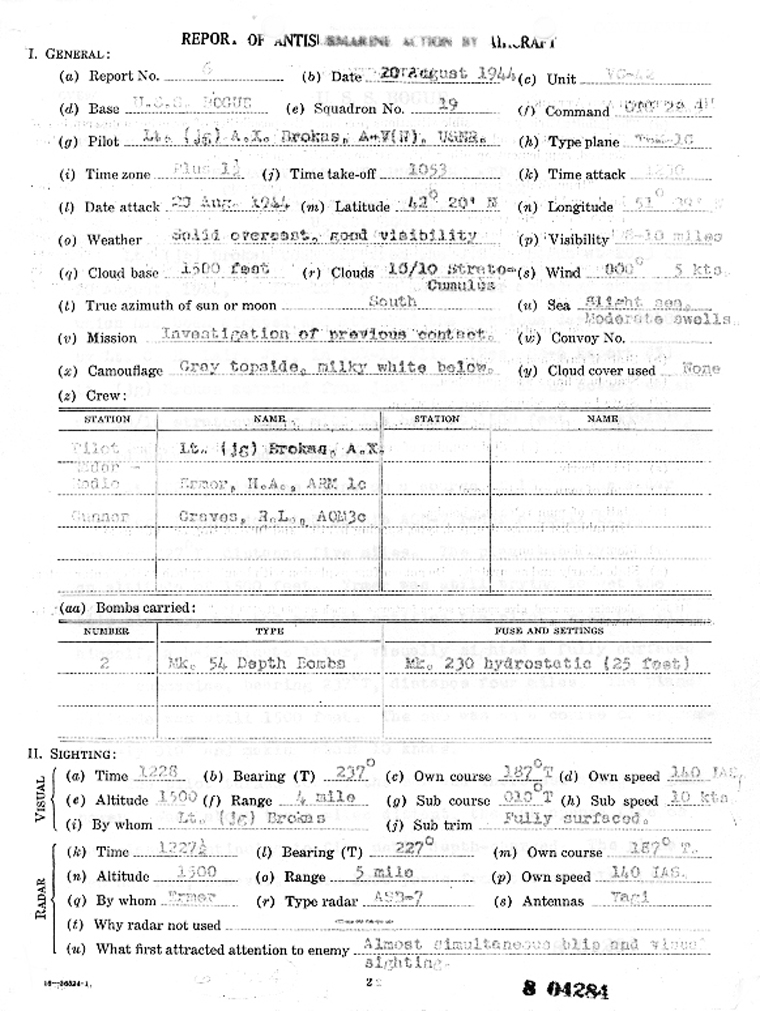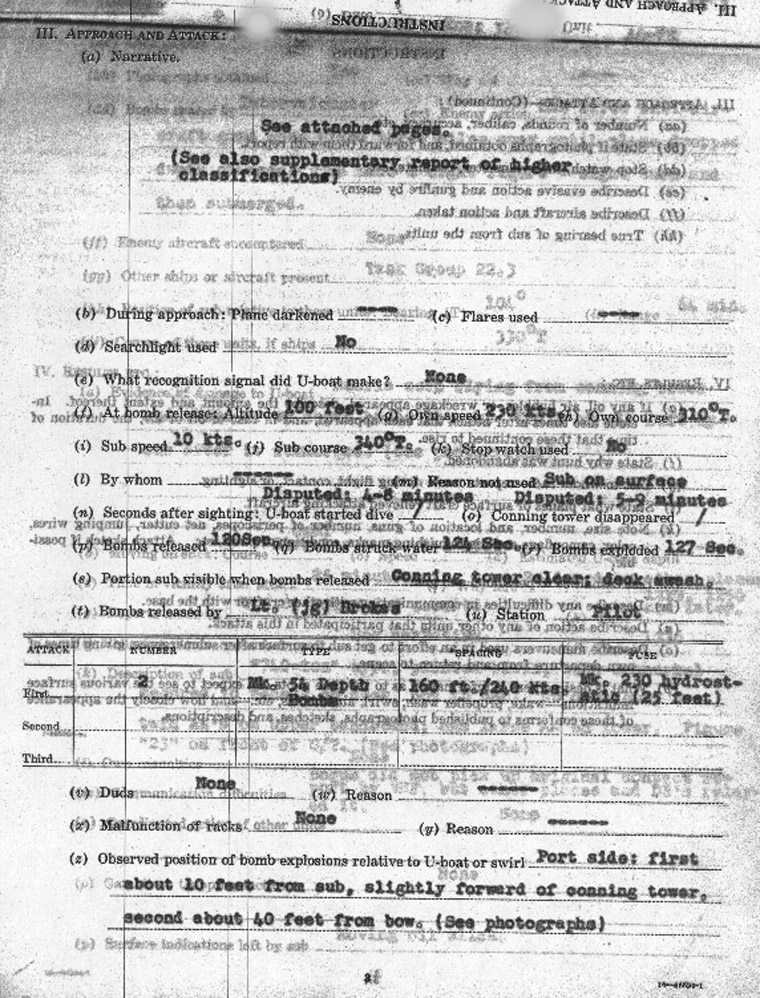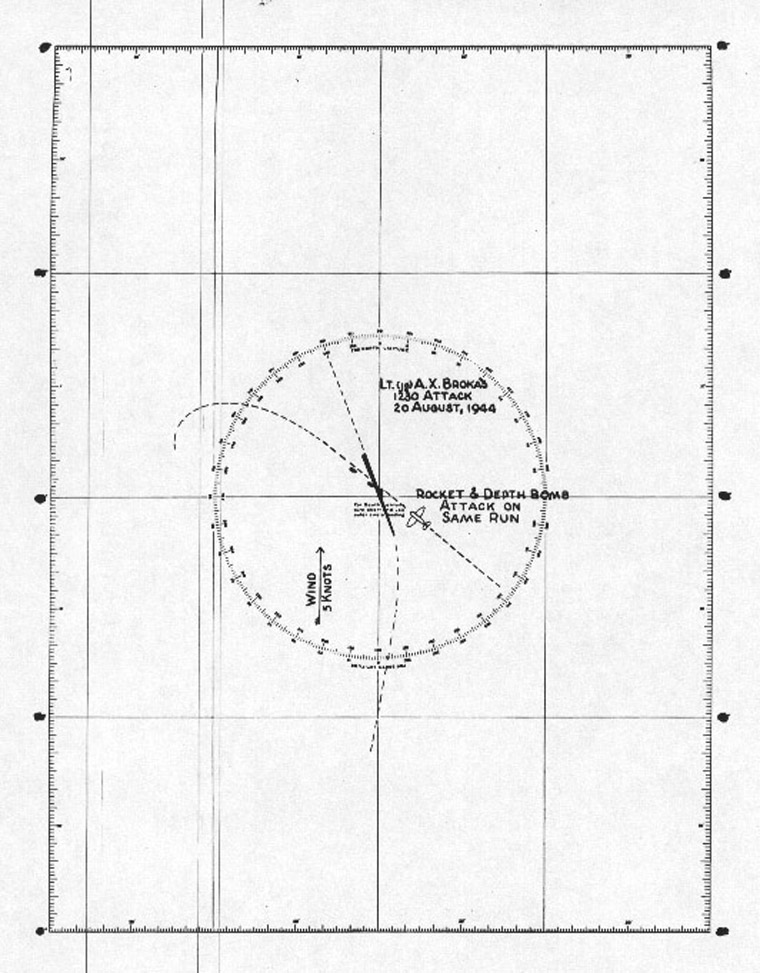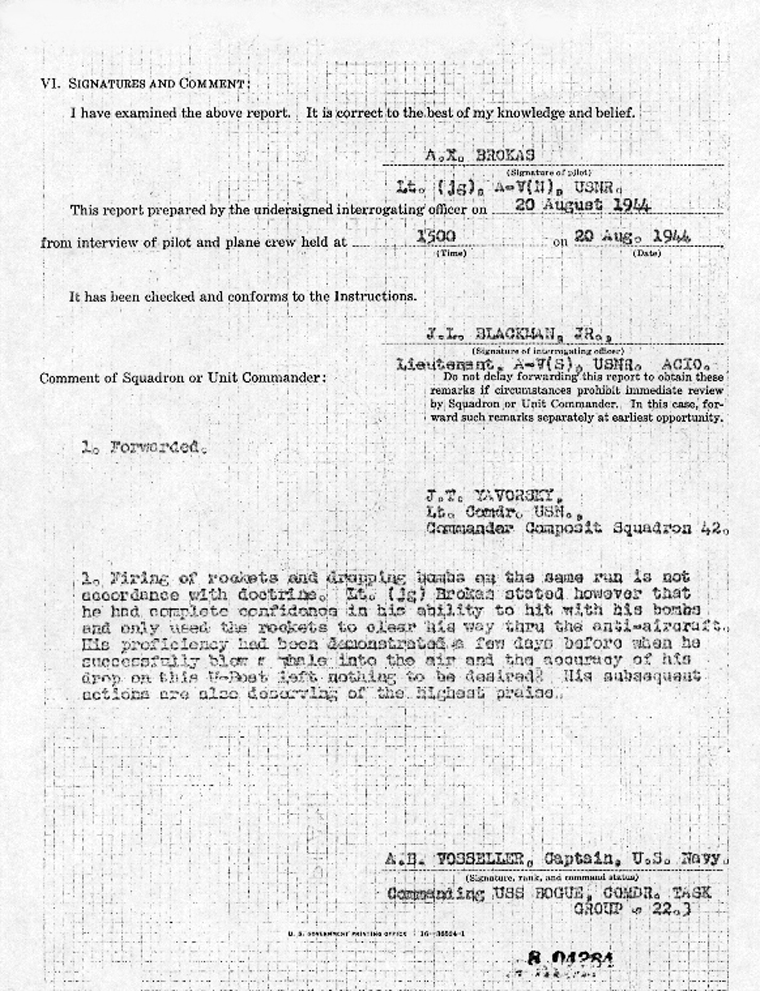




U. S. S. BOGUE |
||
| CVE9/ | ||
| VC-42 |
||
| ASW-6 #6 |
||
NARRATIVE OF ANTISUBMARINE ATTACK |
||
OF LT.(jg) A. X. BROKAS, VC-42 |
||
20 AUGUST 1944. |
||
U.S.S. BOGUE |
||
| Lt.(jg) Brokas took off from the U.S.S. Bogue at 1053 on 20 August, 1944, in TBM-1C #19 on search for an enemy submarine which had been sighted and attacked the previous day (at 0040) by Lt. C. E. Lair, Jr., in TBM-1D #11. (See ASW-6 Report #5.) Lt.(jg) Brokas searched from just under the cloud cover, which was 10/10 stratocumulus with its base at 1500 feet. Visibility varied between 5 and 10 miles. |
||
| At 1227½, with the plane on a course of 1870T, the radar operator, Ermer, detected on his ASB-7 radar a small blip, bearing 2270T, distance five miles. The plane was flying at an altitude of 1500 feet. Ermer was still trying to get the blip clearer, and had not yet notified the pilot, when the pilot himself, a half-minute later, visually sighted a fully surfaced submarine, bearing 2370T, distance four miles. The plane’s altitude was still 1500 feet. The sub was on a course of approximately 0100 and making about 10 knots. |
||
| The pilot turned toward the sub and increased speed to full power. When about three miles distant, the sub opened fire on the plane, continuing to fire until depth charged. The plane was not hit, however. When 1200 yards from the sub, Lt(jg) Brokas launched a rocket attack with his Mk. 5, 3.5” forward-firing aircraft rockets. After releasing a salvo of two rockets, he fired similar salvos at 1000 yards, 800 yards, and 600 yards, respectively. Most of the salvos were short, but the last one hit well within the standard limit of 67 feet. However, the sub had begun an evasive turn to the left which caused the last two rockets to reach the sub at an oblique angle. (See photographs.) | ||
| The evasive turn, to a course of about 3400T, caused the sub to present her starboard quarter to the airplane for a perfect depth bomb run. Lt.(jg) Brokas released his two Mark 54 depth bombs in train, spaced at 160 feet/240 knots by intervelometer. At the release point, the plane was at 100 feet altitude, making 230 knots. The bombs hit on the far side (port), one very close aboard just to port of the conning tower, and the other about 40 feet from the bow. (See photographs.) As the plane pulled up and turned to port, the gunner, Graves, fired his turret gun at the conning tower on which a man could be seen standing. The gunner said he could see debris fly off the conning tower, from the depth bomb explosion and the pilot reported he saw “something fly off the stern.” Prisoners of war later stated that five men were knocked off the conning tower by the explosion, and one gun was blown off. | ||
| As the plane made figure-eights in the sky, the U-boat made a tight 3600 turn to the right, then a similar 3600 turn to the left (a figure-eight on the water). The sub did not resume antiaircraft fire. The U-boat then zig-zagged briefly and submerged, “in a settling fashion, stern lower than the bow, and with very little wake,” the pilot said. The figure-eight turn was executed so rapidly that the pilot reported the craft made “virtual right-angle turns.” He timed the figure-eight at two minutes by his watch and insisted there could be no mistake. (This would mean that each 3600 turn was made in 60 seconds. Since ONI-220GE states that the minimum time for a 3600 turn by a German submarine is 175 seconds, this figure is being used alternatively in this report.) The time of submergence of the U-boat thus is computed alternatively as 1233 or 1237, depending on whether the sub made its turns in one or three minutes each. | ||
| The photos and the pilot’s observations showed that Schnorkel was installed on this submarine, but was lowered and not in use at the time of the aircraft attack. The pilot believes that if Schnorkel had been raised as the sub maneuvered after the attack and just before submerging, he would have noticed it. It is thus believed that the sub submerged with Schnorkel lowered. Two hours later, when the U-boat surfaced less than a mile from where it had gone down, Schnorkel was up. This suggests that the German submarines are able to raise Schnorkel while submerged.(See photos of Schnorkel with ASW-6 #7.) |
||
| As the U-boat settled beneath the surface at 1233 or 1237, Lt.(jg) Brokas flew down the sub’s track in a special attack, dropping a purple sonobuoy right on the swirl within 15 seconds of submergence. The radioman turned on the wire recorder, which was connected with the ARR-3 receiver, and listened to the purple buoy for 12 to 15 minutes, recording it on the wire. A replaying of the record following the flight disclosed clear rhythmic sounds like propeller beats lasting 55 seconds, at which time they stopped suddenly. Only metallic hammering and other loud noises were heard thereafter. This was interpreted by the civilian sonobuoy technician attached to the Bogue, Mr. Raymond Murphy, as indicating the sub had lost way after the period of 55 seconds and was making or attempting repairs under the surface. Further evidence of this was seen in the oil slick left by the submarine –- a slick which extended about a half-mile from the point of submergence, turned sharply to the left for about another half-mile, then stopped. While the radioman listened to the sonobuoy in the plane, the pilot disconnected the ARR-3 from the interphone to handle communications, and dropped additional sonobuoys, re-connected it intermittently. A standard pattern of four buoys was dropped around the purple one as a center, the colors dropped being: blue, red, yellow and green. Of these, only the red buoy functioned properly, but it gave no submarine indications. While laying this pattern, Lt.(jg) Brokas noticed the significant oil slick and marked it with a smoke float. (See photographs with this report.) |
||
| Meanwhile, the Bogue was mobilizing planes and surface craft to come to Lt.(jg) Brokas’s assistance. Three TBM’s, which were in the air on other sectors of the same search, were vectored to the scene. Two other TBM’s and two FM-2’s were launched and sent to relieve him. Four of the five destroyer escorts in the task force were dispatched promptly. At 1336, Lt.(jg) Mabry reached the scene in TBM-1C #12. He was immediately directed to climb to 7000 or 8000 feet to permit the carrier to obtain a radar bearing, range and to insure communications. This permitted vectoring other planes to the scene accurately and quickly. At 1349, Lt.(jg) Porter arrived in TBM-1C #18 with Lt.(jg) Sulton in FM-2 #7, escorting Lt.(jg) Sherbring in TBM-1C #21. Using the primary frequency, 3665, Lt.(jg) Brokas called attention of the killer group to the oil slick, beneath one end of which he felt confident the U-boat lay. He told them of the sonobuoys he had dropped, and of the two colors which were functioning –- purple and red. At 1355, he was directed by the carrier by the carrier to return. As he was circling the carrier to land, the U-boat was surfacing, badly wounded, at the end of the oil slick, and was being attacked by other planes of his squadron. At 1425, Lt.(jg) Brokas landed aboard, in time to hear over the radio that the enemy submarine had just sunk, bow first, and blown up, leaving 42 survivors in the water. | ||
| VC-42 |
||||||||||||||||||||||||||||||||||||||||||||||||
| ASW-6 #6 |
||||||||||||||||||||||||||||||||||||||||||||||||
CHRONOLOGY OF ANTISUBMARINE ATTACK |
||||||||||||||||||||||||||||||||||||||||||||||||
OF LT.(jg) A. X. BROKAS, VC-42 |
||||||||||||||||||||||||||||||||||||||||||||||||
20 AUGUST 1944. |
||||||||||||||||||||||||||||||||||||||||||||||||
U.S.S. BOGUE |
||||||||||||||||||||||||||||||||||||||||||||||||
|
||||||||||||||||||||||||||||||||||||||||||||||||